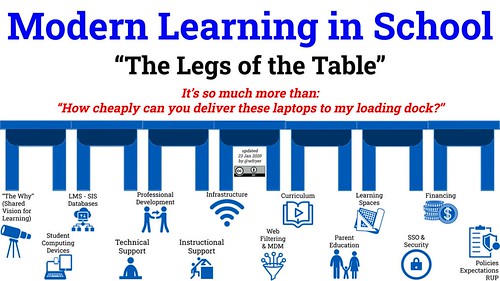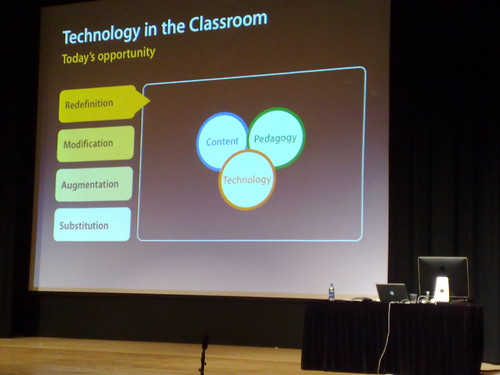Modern Learning in School: The 14 Legs of the Table
Author: Wesley Fryer
Go to Source
Modern Learning in school today is a complex undertaking which requires a robust strategy of support to be successful.* Today I’m in the Dallas, Texas, area, and had the chance to visit with both Good Shepherd Episcopal School (@gsesdallas) and Prestonwood Christian Academy (@PrestonwoodPCA) teachers, students and staff with a team from our school in Oklahoma City. At the end of our day, I created the following graphic to represent my understanding of the 14 different elements of successful “modern learning in school” involving Internet-connected digital devices for learners. In this post, I’ll briefly highlight and define what I understand each of these elements / legs to mean. I’d love to hear from you (either via a Twitter reply to @wfryer, a Facebook post comment, or a blog post comment below) on what’s missing from this model / framework, or your responses / feedback to these ideas. A larger version of this graphic is available on Flickr and as a Google Drawing. It’s shared under CC-BY.
Here are the fourteen legs of the table of “Modern Learning in School.” For an earlier iteration of this, listen to my podcast, “Planning for 1:1 Project Success” from 13 years ago in October 2006.
1. “The Why”
What is the shared vision for learning at our school? What does, can, and should learning inside and outside the classroom look, sound, and feel like? Part of our answer to this question today is our “Portrait of a Graduate.” Other elements involve “making thinking visible,” “durable learning” (which persists long after formal assessments are over) and “peak learning moments.” Engagement and multi-disciplinary / cross-curricular learning are also elements of this vision.
2. Student Computing Devices
Learners in the twenty-first century require access to digital, Internet connected devices to become fully literate and thrive in our society. Whether that device is a Chromebook, a laptop, an iPad, or other kind of tablet, it’s essential students as well as teachers have access to Internet connected devices which not only allow them to access and consume media in various forms, but also create and share media. Learners should have the opportunity to regularly “show what they know with media.” This “new normal” for modern learning requires ubiquitous access to digital computing devices.
3. LMS – SIS – Databases
Modern learning requires sophisticated database support. Schools require learning management systems (LMS) and student information systems (SIS) to digitally manage student data including attendance, grades, assignments, and curriculum.
4. Technical Support
The roles and importance of technology hardware and software programs, which are increasingly Internet connected, have grown dramatically in the past decade and are on track to continue this growth pattern. Modern learners in schools need access to “help desk” staff and “genius bar” style support to fix problems and get technology devices working again quickly when problems are encountered. Information Technology (IT) support goes beyond “level 1 triage” of immediate problems, however, and includes support for a wide variety of Internet- connected devices and network-delivered services. (See my February 2019 post, “Lessons Learned as a School Director of Technology” for more details on this range of devices to support.)
5. Professional Development
Schools historically tend to under-invest in professional development for teachers. Modern learning requires that schools cultivate cultures of ongoing and continuous learning among teachers. This not only includes summer and school year workshops, conferences, and meetings for teachers, it also should include “just in time” support at department, grade level, individual and after-school meetings which allow for “showing and sharing,” collaboration, and learning about new tools and strategies which support student as well as professional learning.
6. Instructional Support
IT (Information Technology) support alone is insufficient for modern learning in schools. Instructional support, including educational technology focused support but also including lesson design / pedagogical support, is also vital. Schools support modern learning by providing certified, instructional coaches who are available to meet regularly with teachers to brainstorm, co-teach, design, deliver and facilitate lessons with students.
7. Infrastructure
Modern Learning, increasingly powered by cloud-connected digital devices and services, requires a robust technology infrastructure of fiber optic cabling, ethernet cabling, network switches, WiFi access points, firewalls, and other server computers with various functions. Many server functions which have historically been hosted locally can and should be “moved to the cloud,” but some applications require local server support. All these infrastructure elements must be regularly updated as well as maintained to create a digital learning environment where web resources are accessed by students, teachers, and staff as naturally as we breathe air.
8. Web Filtering and MDM
As the resources and positive learning potential of modern learning continues to increase, the potential for those resources and technologies to be abused and used for malicious / inappropriate purposes has also grown. We live in a “seek and find world,” and media inappropriate for classroom use (and arguably any constructive use) can be only a few mouse clicks or touchscreen taps away. In this environment (also regulated by the eRate requirements in the United States) it is imperative for all schools to provide web content filtering as well as monitoring of student digital devices. The effective and efficient management of digital devices with required software and applications today in schools requires the use of mobile device management (MDM) platforms.
9. Curriculum
Throughout human history, learning has always required ideas, content and curriculum. As oral traditions gave way to written texts, teaching and learning models changed. Similarly today, as curriculum becomes increasingly digital, the strategies employed by teachers and students to engage in learning are also evolving. Digital textbooks / ebooks are one form of curriculum today, but the landscape of curriculum is more diverse as well as fractured than ever. Modern learning requires curriculum, which can include required media (textbooks) but also a wide variety of web resources and interactive learning platforms.
10. Parent Education
Parents expect many things from schools, teachers and administrators. Since the arrival of the World Wide Web and Internet connected devices in schools and our homes, and the explosive growth of digital communication technologies including social media, parents have had and continue to have many concerns and fears about the ways these tools are used and their impact on their children. Screentime concerns today are prominent in the minds of many parents, just as fears about Internet predators were ten years ago. Both are real issues and important to address. Screentime is not monolithic, however, and helping parents as well as teachers “see” and understand this is critical. School leaders and teachers need to regularly and intentionally communicate with parents to explain the ways we are working to mitigate/reduce online risks, promote responsible technology use, monitor use to support accountability, and helping empower students to develop their executive capacities to make good choices in our digital world.
11. Learning Spaces
Modern learning requires far more than Internet-connected devices and curriculum. The layout of the classroom, the desks (and hopefully furniture) available to students, the availability of multiple projection devices: All of these elements of learning spaces create an environment which can be supportive or challenging for modern learning. For more on this, see the 2010 book, “The Third Teacher: 79 Ways You Can Use Design to Transform Teaching & Learning.”
12. SSO and Security
Single-Sign On (SSO) is the process of using a single identity credential to access multiple systems. These can include websites, computing devices, software programs / platforms and physical locks like doors and gates. Many schools today (including ours) use Google Suite for Education for students and teachers. Many online curriculum platforms and web services allow user logins via Google. Others integrate with third party SSO services like Clever or Class Link. These tools are essential to reduce the number of userIDs and passwords modern learners must use and maintain. They also can enhance digital security and accountability. An ongoing focus on digital security, avoiding phishing / identity theft, and protecting both personal and organizational resources is critical for modern learning as well as life. Everyone (at least starting in middle school) needs to be using long, complex and unique passwords on every website / application requiring a login, using a password manager, and using multi-factor authentication whenever possible.
13. Financing
Modern learning is not free. How are the varied requirements of modern learning highlighted in this framework funded? Funding is required to not only launch / start a modern learning initiative, but also sustain it. Adequate staffing for modern learning is essential and can be expensive. Schools utilize a variety of funding mechanisms to start and sustain modern learning.
14. Policies, Expectations and RUP
A variety of school policies and expectations for modern learning are important. These are not limited to students but also extend to parents. Helping students stay safe and make good choices both in classes and in life is and should be an ongoing partnership between parents, teachers, administrators and staff. Many schools have migrated from using an “Acceptable Use Policy” (AUP) to a “Responsible Use Policy” (RUP) for students. We made this transition at our school several years ago, and links to those policies as well as presentation resources shared with our community are available on the “student resources” page of our Digital Citizenship website.
So those are the “14 legs of the table of Modern Learning,” as I see them today. What do you think. What’s missing?
* Shout out to Jason Kern (@jasonmkern) who is the first school Director of Technology / Chief Information Officer I heard about and know who changed his official job title to “Director of Modern Learning.” Also thanks to our trip collaborators and colleagues from The Casady School as well as Good Shepherd Episcopal School and Prestonwood Christian Academy who discussed many of the ideas highlighted in this post with us today. Also thanks to The Noun Project, the source for all the icons used in this graphic.
If you enjoyed this post and found it useful, consider subscribing to Wes’ free, weekly newsletter. Generally Wes shares a new edition on Monday mornings, and it includes a TIP, a TOOL, a TEXT (article to read) and a TUTORIAL video. You can also check out past editions of Wes’ newsletter online free!
Did you know Wes has published several eBooks and “eBook singles?” 1 of them is available free! Check them out! Also visit Wes’ subscription-based tutorial VIDEO library supporting technology integrating teachers worldwide!
MORE WAYS TO LEARN WITH WES: Do you use a smartphone or tablet? Subscribe to Wes’ free magazine “iReading” on Flipboard! Follow Dr. Wesley Fryer on Twitter (@wfryer), Facebook and Google+. Also “like” Wes’ Facebook page for “Speed of Creativity Learning“. Don’t miss Wesley’s latest technology integration project, “Show With Media: What Do You Want to CREATE Today?“


